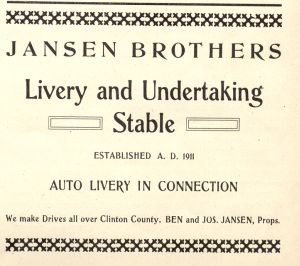St. Bernardís Church
The first settlers in the vicinity of the present town of Albers came from Hanover and Westphalia, Germany, in the early 40ís and attended to their religious duties at Germantown. When later on churches were built at Damiansville and Aviston, those considerably nearer to these places attended divine service there.
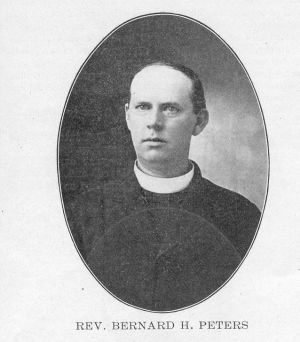
When in the year 1889 a railroad, known as the Air Line, was built, the Company for the convenience of the people of Damiansville, made a stopping-place on the main road from Damiansville, and named it Damiansville Station. A few years later, the name of the Station was changed to Albers Station, the land for the switches and depot having been donated by F. H. ALBERS.
For a number of years there were only five houses at the "Station." Since 1900 gradually one family after the other settled here, till in 1908 there were 12 families residing close by. It being rather inconvenient for those families to attend church at Damiansville, which is 2 Ĺ miles distant, a new congregation as formed, and July 8, 1908, the Rev. Bernard PETERS was appointed the first pastor.
Immediately after his appointment, the Rev. Pastor arranged to build a suitable church. This building is of solid pressed brick, 85 ft. long and 48 ft. wide and has a seating capacity of 420.
The congregation has no rectory, the pastor living in a rented house, but contemplates erecting a parsonage in the near future.
In 1908 a school district had been formed, and all the inhabitants in and around Albers being Catholic, a building was erected on a piece of ground deeded to the Rt. Rev. Bishop.
This building is a frame structure, consisting
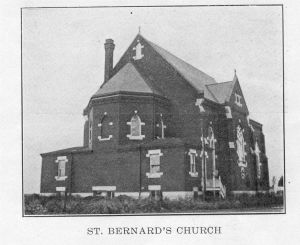
of two rooms with a capacity of 40 pupils to each room. This building was rented from the Bishop by the directors and a Catholic teacher was employed, who also gives instructions in religion.
A
number of societies
flourish, namely:
St.
Bernardís
Married Menís Society, 33 members.
St.
Elizabethís
Altar Society, 42 members.
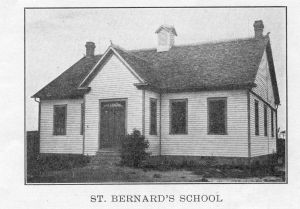
St.
Aloysius Young
Menís Society, 24 members.
St.
Agnes Young
Ladiesí Society, 27 members.
The land for the Cemetery was donated by Mr. Gerhard
NETEMEYER. It comprises three acres and is situated on the main road about on-half mile north of town.
The Parishioners are exclusively native Americans of German descent.
Rev. Bernard PETERS was born on a farm near Germantown and attended the Catholic Schools there. He studied Classics at Teutopolis, Ill, Philosophy at St. Francis Solanus College, Quincy, Ill., and Theology at St. Francis Seminary, St. Francis, Wis., and was ordained priest on June 16, 1895. After being substitute at Fayetteville, Bartelso, Cairo, and St. Francisville the first year, he was
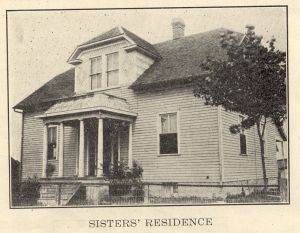
appointed assistant to the Rev. Th. KAMANN at St. Rose and at the same time had charge of the Mission at Beaver Prairie. He served in this capacity from Aug. 13, 1896 until Dec. 21, 1906. On that day he took charge of St. Francisville with Bridgeport as a Mission. On July 8, 1908, he assumed his present pastorate at Albers.
What Albers has:
- A population of 175.
- Three general stores.
- One hardware store.
- One creamery.
- One saw mill.
- Three saloons.
- One barber shop.
- One butcher shop.
- One elevator.
- One lumber yard.
- One blacksmith.
- One livery stable.
Albers is the largest unincorporated town in Clinton County, and is filled with some of the livest and most up-to-date business men in the State. Among them are the following:
Henry TONNIES
Genial and wholesouled Henry TONNIES was born October 16, 1861, on a farm near Germantown, where he worked for his parents until he was 29 years of age. At that time the Southern R. R. was built and in September, 1890 he started a small store and bought wheat for the Germantown mill.
On May 18, 1891, he was appointed Post Master at Albers, which office he is holding still.
In the year 1892 the Southern R. R. Company appointed him ticket, freight and express agent, with a salary of $5.00 per month and commission, which amounted to about $10.00 per month. At the end of his 12th year, he had worked up his salary and commission to $75.00 per month. He also started the milk shipping, and made Albers one of the leading shipping places on the road.
In 1894, in order to get more business to this town, he
and Anton STROOT started a saw mill and connected with it a fuel and corn meal mill and a hydraulic cider press.
On September 10, 1895, Mr. TONNIES married Miss Elizabeth SUDHOLT of Aviston, Illinois.
In 1897 he added another addition to his store.
In 1905 he was elected Highway Commissioner, which office he held for 6 years; during that period the first Rock Road was built in this District. He likewise was instrumental in gaining subscriptions for a telephone line from Albers to Damiansville and New Baden which was built the same year.
To his efforts the building of St. Bernardís new church is largely due as well; so energetic was the preliminary work that on June 23, 1906, the first load of building material for the new church could already be unloaded.
On June 5, 1907, Mr. TONNIES called a meeting to take up subscriptions to drill for coal in order to improve the town and farming district. At the depth of 313 feet a 9-foot vein of coal was found and 60 feet deep a 7-foot vein was found.
On December 16, 1907, he platted and laid out 100 town lots.
On April 2, 1908, the Church Building Committee, of which he was a member, appointed him as the secretary and treasurer, and he was told to order brick and rock and collect subscriptions to pay for same.
In April 1908, he donated and gave a deed to the Rt. Rev. John J. JANSSEN, Bishop of Belleville, of all block No. 6 for church and school purposes.
On August 8, 1908, the first shovel of ground was dug by him for the church foundation, he also ordered all the steel trusses, mill work and lumber.
In 1910 he built a hotel and rented it out to Mr. Frank EILERING.
On March 1, 1912, he started a R.F.D. Route from his Post Office with T. H. STROOT as temporary carrier, who was succeeded by Emil MOLLET as regular carrier.
Owing to his great activity displayed, and his public spirited action the little town of Albers has so flourished
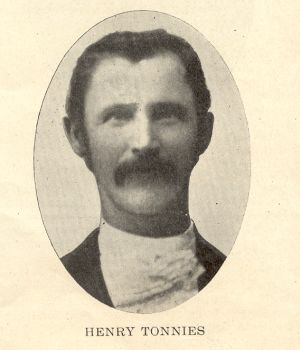
that Mr. H. TONNIES was in 1912 obliged to add an addition to his already large store. Here he is enjoying an ever increasing trade, and he hopes to have abundant opportunity to serve his friends many more years.
Joseph EINHOFF
Located south of the Southern tacks is the general store of Joseph EINHOFF, one of the progressive merchants of the little village of Albers. He has been in business
Page 7
in that place since 1895 and has been steadily increasing his business every year. He carries a $3,000.00 tock of merchandise and does an average business of about $10,000 yearly. He handles everything in the general line. His place of business was the fourth building erected in the town. The building is a two-story frame and covers and area of 36X64 feet. Before locating in Albers Mr. EINHOFF was connected with a general store at Damiansville where he was employed four years. He was born in Westphalia, Germany, in 1875, and came to America in 1891. Shortly after reaching this country he located in Damiansville. He was married in 1898 to Miss Mary SAUTEL, of Damianville. The couple have five children, all living.
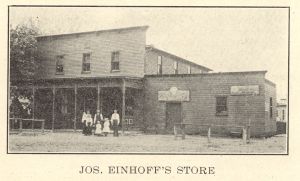
For the early part of his life he attended the common schools of Germany and when he reached this country he attended the Commercial College of Belleville. By hard work and saving he bought a 160-acre farm near Damiansville five years ago on which he raises wheat, corn, oats and garden truck, all of which finds a ready market. He has rented out the farm to people who take good care of it and bring him good returns. It is a paying investment to Mr. EINHOFF.
Francis A. TONNIES
Mr. TONNIES started into business in Albers in 1912 as a general store merchant. That he has succeeded is shown by the fact that he has been kept constantly busy increasing his stock ever since he started in October of that year. He carries a general line of merchandise, including everything that any first-class up-to-date store such as he manages would carry. It is the newest store, so to speak, in the little village. One can judge the size of his store when they read that his stock is valued at $6,000.00, and that his city and country business is very large and that his yearly business will amount to many thousands of dollars. The building is 36X22 feet. Mr. TONNIES was born in Albers in 1888 and has lived there all his
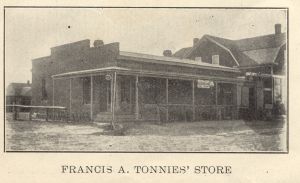
life. He was married in 1910 to Bina HECKENKEMPER, of Albers. His fatherís name was A.H. and his motherís Theresa. His father was a resident of the vicinity of
Albers all his life, having been born on a farm near the present city. His mother came from Werl, Westphalia. Mr. TONNIES is also engaged in the insurance business and is a Notary Public. For several years he was a school teacher in the Catholic School of Albers, having graduated from St. Francis College of Quincy, Illinois. He is a young man who will make a success in Albers, as Albers needs such men has he.
Emil HAAS
Before his death the early part of 1913 Mr. HAAS was connected with the Pevely Dairy Company of Albers as manager. He also operated one of the best paying saloons in the village and was on a fair road to make a great success, but the Grim Reaper came along and took one good man from our midst. He was born in St. Clair County in 1873 and for several years lived in Trenton. He came to Albers in 1900 and started into the saloon business a little over a year ago. For twelve years he was in the grain business in the city and was married in 1897 to Mary BREINER. He leaves six children.
HAYING AT THE UNIVERSITY OF ILLINOIS.
The Dairy department of the University of Illinois is in the midst of its alfalfa cutting. Out of the total one hundred and twenty acres operated by the Dairy department, sixty acres are in alfalfa; the other sixty is in corn. The aim of the Dairy department is to produce as many pounds of total digestible nutrients per acre as possible. It can do this best by raising corn and alfalfa.
The yields of alfalfa thus far have been very good. On the twenty-acre farm, eleven and one-half acres are in alfalfa. This yielded two tons per acre: There have been two kinds of seeding used; spring seeding, and summer seeding. This year the spring seeding yielded 2.73 tons per acre, and the two-year old summer seeding yielded 2.51 tons per acre.
FARMERS' EXPOSITION.
In some respects the farmer will shine supreme in the big San Diego Exposition to be held in 1915 to celebrate the opening of the Panama Canal. Irrigation will be one of the chief features, but there will be demonstrations of forestation also, and of reclamation, conservation, etc. Some model farms and orchards will prove especially interesting. The enterprising orange growers of California have already planted a ten-acre tract with lemon and orange trees which will make a splendid showing by 1915. It will be very largely a farmers' exposition.
